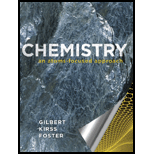
To find:
To compare the number of atoms of uranium and diamond in a cube (having 1 cm on a side) made of each of these two elements.
Answer to Problem 2.83QA
Solution:
The cube made up of diamond contains more atoms.
Explanation of Solution
Concept:
The volume of two cubes made up of Uranium and Carbon are same. Only these two elements have different values of densities.
So, the masses of uranium and diamond cubes will be different since
Mass = Volume x Density
So, here, firstly, the given masses of each cube have to be calculated separately by using the above formula.
Atomic masses of Uranium and Carbon are known.
A mole is the SI unit of amount chemical substance. When writing units, it is written as “mol”.
Formula:
i)
ii) The number of atoms of each element = Number of moles x Avogadro number
Given information:
Density of Uranium =
Density of Carbon (Diamond) =
Length of each side of cube =
Atomic mass of Diamond =
Calculation:
We will calculate the volume of cube from the 1 cm edge length.
We will calculate the mass of uranium from volume and density.
Now calculate the moles of uranium atom by using
We will calculate the number of atom by using the Avogadro’s number.
So
Now we will calculate the mass of diamond from volume and density.
Now calculate the moles of uranium atom by using 3.514 g and atomic weight.
We will calculate the number of atom by using the Avogadro’s number.
So, the cube of diamond contains more number of atoms than uranium.
Conclusion:
We calculate the number of atom from the edge length of cube, atomic mass and Avogadro’s number.
Want to see more full solutions like this?
Chapter 2 Solutions
Chemistry: An Atoms-Focused Approach
 ChemistryChemistryISBN:9781305957404Author:Steven S. Zumdahl, Susan A. Zumdahl, Donald J. DeCostePublisher:Cengage Learning
ChemistryChemistryISBN:9781305957404Author:Steven S. Zumdahl, Susan A. Zumdahl, Donald J. DeCostePublisher:Cengage Learning ChemistryChemistryISBN:9781259911156Author:Raymond Chang Dr., Jason Overby ProfessorPublisher:McGraw-Hill Education
ChemistryChemistryISBN:9781259911156Author:Raymond Chang Dr., Jason Overby ProfessorPublisher:McGraw-Hill Education Principles of Instrumental AnalysisChemistryISBN:9781305577213Author:Douglas A. Skoog, F. James Holler, Stanley R. CrouchPublisher:Cengage Learning
Principles of Instrumental AnalysisChemistryISBN:9781305577213Author:Douglas A. Skoog, F. James Holler, Stanley R. CrouchPublisher:Cengage Learning Organic ChemistryChemistryISBN:9780078021558Author:Janice Gorzynski Smith Dr.Publisher:McGraw-Hill Education
Organic ChemistryChemistryISBN:9780078021558Author:Janice Gorzynski Smith Dr.Publisher:McGraw-Hill Education Chemistry: Principles and ReactionsChemistryISBN:9781305079373Author:William L. Masterton, Cecile N. HurleyPublisher:Cengage Learning
Chemistry: Principles and ReactionsChemistryISBN:9781305079373Author:William L. Masterton, Cecile N. HurleyPublisher:Cengage Learning Elementary Principles of Chemical Processes, Bind...ChemistryISBN:9781118431221Author:Richard M. Felder, Ronald W. Rousseau, Lisa G. BullardPublisher:WILEY
Elementary Principles of Chemical Processes, Bind...ChemistryISBN:9781118431221Author:Richard M. Felder, Ronald W. Rousseau, Lisa G. BullardPublisher:WILEY





